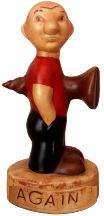 |
 The Virtual Corkscrew Museum's Weekly Newspaper |
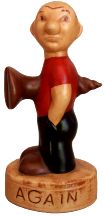 |
 |
 The Virtual Corkscrew Museum's Weekly Newspaper |
 |
|
Sunday, April 12, 2009 |
Number 552 |
Hot Links
A Spectacular Corkscrew by Rob Higgs - Watch the Video! - the six minute video includes discussions by the artist, drawings, manufacture of parts, and the marvellous corkscrew in operation.
Corkscrew Auction - ICCAuctions number 3 is now open - This is your opportunity to buy quality corkscrews at auction without having to wade through hundreds of listings of junk.
The Just for Openers convention is scheduled for April 22-26, 2009 in Troy (Detroit), Michigan.
The CCCC will meet in London August 21-23, 2009.
Let's Do the Twist
Editor's Note: This article is from American Tool Making and Interchangeable Manufacturing by Joseph Vincent Woodworth published by The Norman W. Henley Publishing Company in 1905. The book was illustrated with original drawings by the author.
A Machine for Twisting Corkscrews
The machine here shown [Fig. 1] was made for twisting wire corkscrews of the type shown above. The wire before the twisting is shown below the corkscrew. It is "looped" at one end and bent, while the other end is pointed. The cutting off of the length of wire and the pointing of one end are accomplished in one operation by means of two simple tools in the monitor; the tool used for pointing being a "needle" box-tool, and the one for cutting off a "chopping-tool." The second operation on the wire lengths, that of bending and forming the "loop," is done by hand, with a simple bending fixture not of sufficient interest to show here.
Figure 1
The drawings [Figs 1, 2, and 3] of the twisting-machine show its construction and little description will be necessary. The machine consists of, first, a body or main casting on which are four standards for bearings for two shafts. The pulley, clutch, and small driving-gear require no explanation. The wire is clamped between two jaws H H, [Fig. 1], the upper one of which is raised or lowered by the handle and two gears A A turning right and left screws. The mandrel or forming-spindle X is of tool steel finished to fit easily within the sleeve A", which in turn is fitted and keyed to turn with the slide, back and forth within the main spindle V by a key at D. A handle at Z fastened to the forming-mandrel by the set-screw W keeps the mandrel stationary, by a round-headed pin entering the back at Y, while the sleeve with the main spindle rotates and twists the wire. This pin is located in the bracket T, with a spring at the back at S and a handle at R to allow of its being forced back when the mandrel-lever is to be turned.
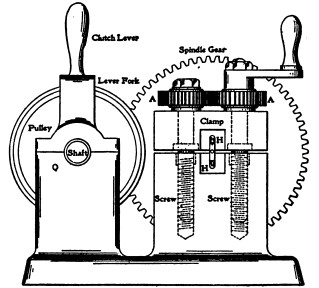
Figure 2
When the machine is in use the work is located and clamped between the two jaws H H, with the pointed end lying in the slots L and M of the sleeve K and the spindle V respectively, and the handle of the forming-mandrel located and held by the pin T, [Fig. 1]. The clutch-lever is then pulled back and the spindle V and the sleeve K rotate while the forming-mandrel remains stationary, thus twisting the wire around the mandrel to the shape shown in the half-tone. The clutch-lever is then pulled out and the machine is stopped when Z is released and turned toward the left, thus drawing out the sleeve and mandrel, leaving the finished corkscrew so that it can be removed by loosening or raising the upper jaw H. The mandrel and sleeve are then slid back in position, another piece of wire is located, and the operations are repeated.
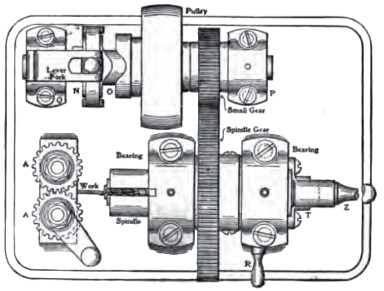
Figure 3
The German Wier
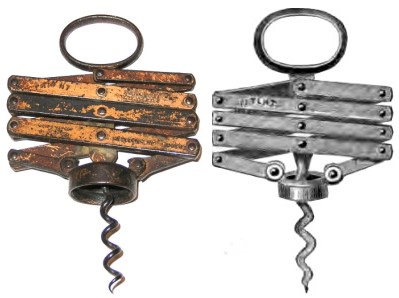
Above left is a Lazy Tongs corkscrew marked HEELEY & SONS MAKERS and WEIR'S PATENT 12804 25 SEPTR 1884 and UNDERWOOD, 56 HAYMARKET.The father of the lazy tongs corkscrew was Marshall Wier. An abridged version of his patent specification reads "The screw is attached to a centre pin on the lowest pair of cross-bars of the lazy-tongs, and the ring, which passes over the bottle neck, is hinged to the side bars, suitable stops being provided to prevent lateral motion when the corkscrew is closed. A suitable handle is hinged at the other end of the lazy-tongs."
The drawing on the right is from the July 1887 issue of The American Druggist. The drawing accompanied this brief notice entitled "Lever Corkscrew":
The lever corkscrew which is here illustrated is a German contrivance for opening bottles, which is based on the principle of the so-called "lazy tongs," and is very simple. While shut, the corkscrew is firmly screwed into the cork, and traction is then made at the handle. This causes the "tongs" to spread and to press upon the neck of the bottle, at the same time while the screw portion bearing the cork is lifted by double leverage. The removal of corks is greatly facilitated by this contrivance, and the bottle is protected against fracture by the simultaneous application of the lever at both sides. The little apparatus, therefore, fulfils the purpose of removing corks rapidly and safely. Price. 4.50 marks; free of postage, 5 marks. Apply to E. Cohn, Berlin, S. W. Leipzigerstrasse 88.
Wier's British 1884 patent was followed by Patent No. 330,357 issued in the United States November 10, 1885.
Editor's note: A Wier's design corkscrew with the words "Guild of Sommeliers. In vino felicitas" was produced in the late 20th Century and can frequently be found on Internet auction sites. The Guild was founded in 1953. Popping up even more frequently on the Internet is a fairly new example marked WINCHESTER.
John Sheridan's Patent
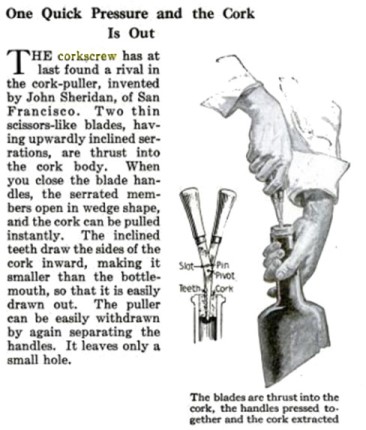
From Popular Science, January, 1918
John Sheridan applied for a patent for his unusual cork pulling invention on August 8, 1916. U. S. Patent 1,240,610 was granted September 18, 1917. In 1966, his patent was the only patent cited in Palace J. Neely's U. S. Patent No. 3,405,963 for a "Fish-Holding Tool" having a similar design.
Wilson's Cork Screw Picket
A story about the Wilson Cork Screw Picket Corkscrew appeared in the December 16, 2007 issue. The above advertisement is from the Homestead published in Des Moines, Iowa on August 12, 1898.
Jones Correction
RE: http://www.bullworks.net/daily/03mar16f.htm
Just a quickie to correct your story of Jenny Jones on the website! Jenny Jones was known as the beauty of Llangollen, she apparently waited 20 years for her lover to return from sea, and a song was written in her memory "My sweet Jenny Jones" This is a favourite tune with Morris dancers, what more can I say. The young lady who saved pennies and later walked just 26 miles to the town of Bala (not London) to buy a bible specially printed in Welsh, was Mary Jones - she later was famous for founding the Welsh Bible society to promote the distribution of Welsh bibles. This is a very common mistake, but as a specialist in selling both Mary Jones and Jenny Jones related items, I thought you would be interested in correcting your website.There are many hundreds of JJ related items and I know of at least 100 different corkscrews/bottle openers with her image. Mary jones is much rarer as a commercial image, but is always shown holding a bible, she is most often shown on door knockers and bookmarks! Best regards, Ken
|
©2009 Don Bull, Editor |